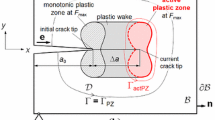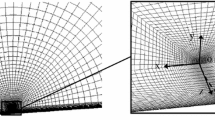The paper describes the energy approach, which is employed for the development of the calculation model to determine the subcritical growth period of short fatigue cracks in elastic-plastic plates using the specific energy components. The authors propose the formula for the approximate determination of the short crack tip opening displacement via the relative loading level of the plate and the stress intensity factor. The obtained results are compared with the known experimental data. From the proposed model and comparison of the obtained results with the experimental ones it follows that the crack growth rate can be different at similar stress intensity factors under various relative loading levels of the plates with a short crack. However, the proposed model retains the dependence of the short crack growth rate on the specific work of plastic deformations in the pre-fracture zone, or on the crack tip opening displacement with the unchanged averaged stresses.




Similar content being viewed by others
Abbreviations
- l * :
-
critical crack length
- l 0 :
-
initial crack length
- p :
-
loading parameter of plate
- δ t max (0), δ t min (0):
-
maximum and minimum crack tip opening displacements (CTOD) δ(t ) per cycle, respectively
- δ fc :
-
critical CTOD value δ t (0) under cyclic loading
- δ th max :
-
maximum threshold CTOD with no crack propagation
- σ t :
-
average stress in the pre-fracture zone
- α 0 :
-
constant defined from the experiment
- V :
-
fatigue crack propagation rate
- ξ:
-
relative loading level of plate
- K Imin , K I max :
-
minimum and maximum values of stress intensity factor (SIF) per cycle, respectively
- R :
-
stress ratio via SIF KI , R = K I min /K I max
- R δ :
-
strain ratio via CTOD δ, Rδ = δ min /δ max
- E :
-
Young’s modulus
- K fc :
-
critical SIF value under cyclic loading
- K th :
-
threshold SIF
- N * :
-
subcritical fatigue crack growth period
References
J. Schijve, “Fatigue of structures and materials in the 20th century and state of the art,” Mater. Sci., No. 3, 7–27 (2003).
V. T. Troshchenko, Deformation and Fracture of Metals under High-Cycle Loading [in Russian], Naukova Dumka, Kiev (1981).
V. V. Panasyuk (Ed.), Fracture Mechanics and Strength of Materials [in Russian], Handbook in 4 volumes, Vol. 4: O. N. Romaniv, S. Ya. Yarema, G. N. Nikiforchin, et al., Fatigue and Cycle Crack Resistance of Structural Materials, Naukova Dumka, Kiev (1990).
R. O. Ritchie and S. Suresh, “Mechanics and physics of the growth of small cracks,” in: Behavior of Short Cracks in Airframe Components, Advisory Group for Aerospace Research and Development, Proc. No. 328 (1983), pp. 1.1–1.14.
K. J. Miller, “The behavior of short fatigue cracks and their initiation. Pt. II. A general summary,” Fatigue Fract. Eng. Mater. Struct., 10, No. 2, 93–113 (1987).
D. Davidson, K. Chan, R. McClung, and S. Hudak, “Small fatigue cracks,” Compr. Struct. Integr., 4, 129–164 (2003).
K. Tanaka and Y. Akiniwa, “Modeling of fatigue crack growth: mechanistic models,” Compr. Struct. Integr., 4, 165–189 (2003).
O. M. Herasymchuk and O. V. Kononuchenko, “Model for fatigue life prediction of titanium alloys. Part 1. Elaboration of a model of fatigue life prior to initiation of microstructurally short crack and a propagation model for physically short and long cracks,” Strength Mater., 45, No. 1, 44–55 (2013).
H. Nisitani and N. Kawagoishi, “Fatigue crack growth law in small cracks and its application to the evaluation of fatigue life,” Trans. Jpn. Soc. Mech. Eng. A, 49, 431–440 (1983).
D. Taylor and J. F. Knott, “Fatigue crack propagation behavior of short cracks; the effect of microstructure,” Fatigue Fract. Eng. Mater. Struct., 4, No. 2, 147–155 (1981).
N. Kawagoishi, H. Nisitani, and T. Toyohiro, “Minimum fatigue crack length for the application of small-crack growth law,” JSME Int. J., 35, 234–240 (1992).
H. Nisitani and M. Goto, “Effect of stress ratio on the propagation of small crack of plain specimens under high and low stress amplitudes (fatigue under axial loading of annealed 0.45% C steel),” Trans. Jpn. Soc. Mech. Eng. A, 50, 1090–1096 (1984).
H. Nisitani and M. Goto, “Relation between small-crack growth law and fatigue life of machines and structures,” Trans. Jpn. Soc. Mech. Eng. A, 51, 332–341 (1985).
M. Goto, T. Maehata, H. Nisitani, and H. Miyagawa, “Small-crack growth behavior of annealed 0.34% C steel plain specimens in oil environments,” Trans. Jpn. Soc. Mech. Eng. A, 58, 348–352 (1992).
N. Kawagoishi, H. Nisitani, M. Goto, et al., “Statistical investigation of the fatigue life based on small-crack growth law,” Trans. Jpn. Soc. Mech. Eng. A, 59, 57–61 (1993).
A. Carpinteri (Ed.), Handbook of Fatigue Propagation in Metallic Structures, Elsevier Science, Oxford (1994).
H. Nisitani, N. Kawagoishi, and M. Goto, “Growth behavior of small fatigue cracks and relating problems,” in: A. Carpinteri (Ed.), Handbook of Fatigue Propagation in Metallic Structures, Elsevier Science Ltd., Oxford (1994), pp. 733–778.
O. E. Andreykiv and M. B. Kit, “Determination of the subcritical growth period of cracks in structural elements under their bifrequency loading,” Mashinoznavstvo, No. 2, 3–7 (2006).
M. Shata and Z. Terlets’ka, “Energy approach in mechanics to fatigue propagation of macrocrack,” in: V. V. Panasyuk (Ed.), Fracture Mechanics and Strength of Structures [in Ukrainian], Kamenyar, Lviv (1999), pp. 141–148.
A. E. Andreykiv and A. I. Darchuk, Fatigue Fracture and Lifetime of Structures [in Russian], Naukova Dumka, Kiev (1992).
V. V. Panasyuk, Mechanics of Quasi-Brittle Fracture of Materials [in Russian], Naukova Dumka, Kiev (1991).
Y. Murakami (Ed.), Stress Intensity Factors Handbook, Pergamon Press, Oxford (1987).
D. J. Hayes and J. G. Williams, “A practical method for determining Dugdale model solutions for cracked bodies arbitrary shape,” Int. J. Fract. Mech., 8, No. 3, 239–256 (1972).
H. Nisitani and N. Kawagoishi, “Relation between fatigue crack growth law and reversible plastic zone size in Fe–3%Si alloy,” in: Proc. of VI Int. Congr. on Experimental Mechanics, Vol. 2, Portland, ME (1988), pp. 795– 800.
Author information
Authors and Affiliations
Corresponding author
Additional information
Translated from Problemy Prochnosti, No. 6, pp. 53 – 63, November – December, 2017.
Rights and permissions
About this article
Cite this article
Andreykiv, O.E., Shtayura, N.S. & Yarema, R.Y. Energy-Based Approach to Evaluation of Short Fatigue Crack Growth Rate in Plates. Strength Mater 49, 778–787 (2017). https://doi.org/10.1007/s11223-018-9923-7
Received:
Published:
Issue Date:
DOI: https://doi.org/10.1007/s11223-018-9923-7




